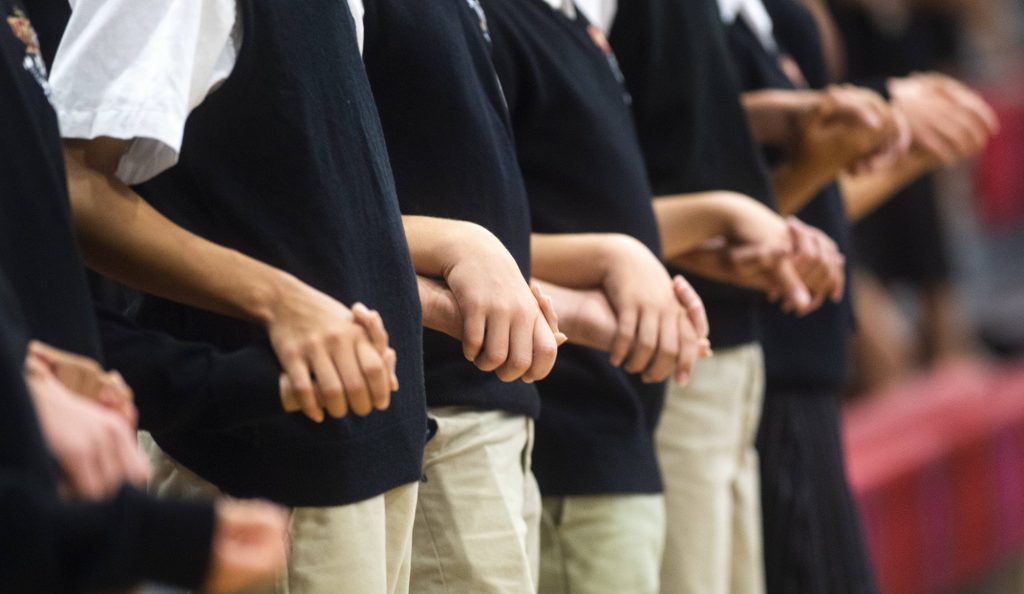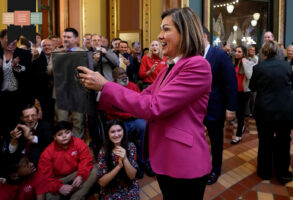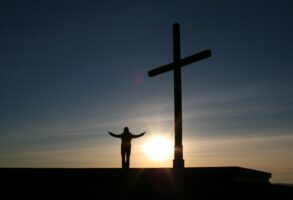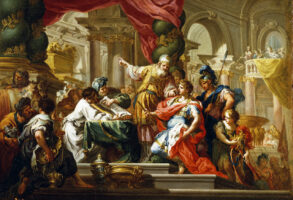
Published September 23, 2019
National Affairs - Fall 2019 issue
Religious and tradition-minded Americans have felt increasingly besieged in our culture in recent years. Every elite institution seems to have turned itself into another combatant in the culture war or an instrument of hyper-aggressive progressivism. This has led some traditionalists to despair of the American experiment, both in theory and in practice.
At the level of theory, the case for this despair is that the principles underlying our liberal society have always harbored a sinister intention to atomize American life, and to pulverize every vestige of religious commitment and traditional attachment. As a practical matter, meanwhile, it can easily seem like the advance of a radical progressivism through our institutions has left the culturally orthodox with no alternative but to escape with their children and leave the larger culture to its sorry fate.
Some on the right offer theoretical responses to these general concerns — defending the liberal order from those who would caricature it as shallow and pernicious. Others advocate staying and fighting for the elite institutions, on the premise that abandoning the field would be irresponsible even if the chances of success are slim. But a better response to the range of post-liberal fatalisms would be more practical, and more constructive. The fact is that our society’s capacity for institution-building remains unparalleled. And maybe more important, there remains in American life a broad, protected space in which dissenters from the popular culture can construct for themselves and their communities an alternative institutional infrastructure that is not merely a venue for dissent or a means of escape but that can instead offer an opportunity to provide examples to the larger society and draw together both champions and converts.
It is true that liberalism creates space for institutions that are hostile to religion and tradition. But it is also true that it creates space for institutions that defend them both, and that can appeal to a swath of our society that wants to be free in an old-fashioned way. It does no good to let the nihilistic tendencies of the liberal society blind us to its potential for moral renewal.
Renewal, of course, is a matter of generational formation — of enabling the young to receive their inheritance as a blessing rather than a curse. And doing that well is a matter of getting education right. That should worry us, because in a lot of ways our society is getting education wrong at this point. But it should also send us searching for examples of how we might do better. And there are such examples today. These can be found not in the realm of public policy, and generally not in the elite coastal cities that shape our popular culture. But they abound nonetheless, in our shockingly variegated country.
Some of the places getting education right are small, liberal-arts-focused universities. These are few and far between, but they also tend to be well known by the people looking for pockets of excellence in American education. Far less well known are the primary and secondary schools preparing even younger Americans for life in a free society. These are the schools that compose what has come to be known as the classical-education movement. By rediscovering and dusting off ancient forms and ideals of education and at the same time utilizing decidedly modern associational forms, these schools have become some of the most successful and thriving educational options in America.
The story of this movement and its origins should chasten even the most despairing of today’s cultural Cassandras. Not only does it demonstrate that renewal is possible, but it also helps us see exactly how it might come to be, and why a countercultural patriotism — a love of our country’s capacity to resist its own worst impulses and to balance its regard for freedom with a desire for the good — might hold the secret to our culture’s future.
That story also shows that meaningful change happens from the bottom up. American associational life at its best grows out of a sense of the transcendent (both religious and secular) that resides in small collectives like the family and immediate community. Higher-order associational life exists for the sake of enriching and enlarging access to the transcendent at that local level. Schools are founded to help the family educate and form children in the light of the highest good. Associations and leagues form to help those schools flourish, share wisdom among themselves, and provide services each cannot provide on its own. Commercial suppliers like publishers and testing companies arise to meet the new needs created and felt by these new social forms. Philanthropic foundations respond to the potential that becomes evident in the work these institutions do together. And finally, organizations devoted to convening all of these various actors open their doors to provide a common public space to help them sustain the progress made.
What characterizes the entire ecosystem involved in this effort is properly placed confidence: confidence in the vision of education according to what is transcendent or sacred, in the notion that education in the light of the transcendent ought to have public purchase in America, and, crucially, in the idea that the associational space provided for and protected by the American way of life is a helpful and fitting venue for developing this vision of education. To see that confidence in action is to restore our own confidence in the assorted associational forms that have always characterized America. These forms are no panacea, nor can they substitute for the revival of healthy families, religious life, and civic devotion. They cannot succeed unless those prior goods are within reach. But these forms make it possible to think concretely about revival in American life, and so ought to keep us from losing faith in the potential of our society to renew itself.
THE REVIVAL OF LEARNING
In September 1981, without much fanfare, the Logos School opened its doors in Moscow, Idaho, with the aim of experimenting with a classically inspired curriculum for primary and secondary grades. According to its website, the school “began with eighteen students in rented facilities at the Paradise Hills Church of God.” After several years, and “after extensive prayer, fund-raising, and remodeling,” it moved into a new facility.
When one of the founders of Logos, Douglas Wilson, wrote Recovering the Lost Tools of Learning in 1991, he generated significant interest from other families and communities about the school’s educational approach. This interest turned into a conference, which led to the formation of the Association of Classical Christian Schools in 1994. ACCS now counts as members over 300 schools that are educating more than 40,000 students.
Meanwhile, independently, a group of Catholic educators began to trace a similar path, eventually launching the Institute for Catholic Liberal Education. The ICLE began its work in 1999, with the goal of reviving the American Catholic K-12 education system. While this is a civic-minded goal, the ICLE also understands itself to stand in contraposition to American culture, which it takes to be increasingly “post-Christian.” For the ICLE, classical education is specifically Catholic, the tradition the Church has always used to educate its members. The downfall of Catholic schools in America has been a turning away from this tradition. The ICLE seeks to revive it. While some of the schools that belong to the group were launched from scratch with this purpose in mind, many have existed for a long time and, because of deficiencies perceived by parents and educators, have come to adopt a classical model of education.
Both the ACCS and ICLE comfortably deploy a vocabulary of “the revival of learning,” which has to do with both the souls of students and the culture of America. Though both groups consider themselves to be outside the mainstream — indeed, countercultural — they nevertheless maintain a civic-minded attitude toward their communities, and a commitment to helping American culture revive through traditional notions about wisdom, virtue, truth, goodness, and beauty.
Nevertheless, there are significant differences between them. The ICLE takes its bearings from the Second Vatican Council and the Catholic Church. The ACCS uses the Apostles’ Creed as a statement of faith and sees itself as an extension of the family, and certainly not within the tradition of the authority of the pope. This is, of course, no small distinction. Yet while the theological difference means they have different primary goals — the ACCS to help Christian fathers fulfill their duty of educating their children; the ICLE to revive education within the Catholic Church — they both appear to share the civic-minded goal of forming students in faith to be good citizens both of church and country.
A third strain of the classical-education movement pursues a related set of goals outside any particular religious framework. Its approach has come to be called “democratic classicism.” It focuses on delivering an education informed not so much by faith tradition as by the conviction that tradition can and ought to be employed to cultivate excellent citizens. The civic-minded dimension is the primary one. In this view, liberal education means cultivating the habits and dispositions of citizenship. Citizenship in liberal democracy requires education since citizenship requires choice, and choice requires exercising one’s freedom with good judgment. Doing so means that the one who exercises judgment must be able to tell the difference between propaganda and persuasion, and this requires a high level of literacy, both spoken and written.
The democratic classical wing developed later than the Christian and Catholic wings of this movement, and it tends to be located in public charter schools rather than private and parochial schools. Two efforts on this front are worth highlighting in particular, both because of their growth and because of their distinct associational models. Together they represent more than 50 schools founded in the last 20 years.
Great Hearts Academies, founded in Phoenix, Arizona, is based on the model of the Tempe Preparatory Academy, which was founded in 1996 in Tempe, Arizona. A group of families was interested in forming a private school but decided to make use of the charter-school mechanism, which had been adopted by the Arizona state legislature in 1994. After less than a decade of success as Tempe Preparatory, some of the leadership split off to form a second school on the same classical model; Veritas Preparatory Academy opened in 2002. The charter management organization called Great Hearts Academies came to operate as a mechanism by which to retain institutional knowledge and quickly deploy the model that had met with some success in a number of communities around Arizona. The network would eventually expand into Texas and come to educate 18,000 students annually. It currently has 30 schools and has recently opened an Institute for Classical Education.
The Institute for Classical Education attempts to develop a convening, research, and public-affairs mechanism for the entire classical-education movement. Whereas Great Hearts schools are already governed by a charter-management organization, the institute aims to bring together researchers, philanthropic foundations, journalists, teachers, and school leaders at its annual symposium, the first of which was held in 2018. It also publishes a quarterly journal, Virtue, which features some of the fellows hosted by the institute each year. The last issue included an essay on the nature of beauty and another on the importance of education in the light of George Eliot’s “meliorism.” It’s not too far off to say that the institute is a kind of think tank devoted to making the public case for classical education and supporting its development among the converted.
Whereas Great Hearts grew out of one school that proved its success quickly, the Hillsdale College Barney Charter School Initiative began as an umbrella and advisory organization whose goal was to spread a model of classical education by delivering curriculum and training to teachers. Each affiliated school is independent but receives services from Barney, especially in its infancy. The initiative now has 24 charter schools in 11 states throughout the country.
Democratic classicism does not share the commitments of faith that define its Christian and Catholic counterparts. But the democratic classical schools are still guided by something they view as transcendent — the nature of man, which contains powers that can be cultivated and directed toward excellence or virtue. Man has the faculty of reason, and therefore the ability to govern himself, and therefore also the ability and perhaps duty to participate in common civic and political life. Where the Christian classical association relies on the Apostles’ Creed and the Catholic classical association the documents of the Second Vatican Council (among other sources, of course), the democratic classical schools take their bearings from the pre-Christian tradition of Aristotelian ethical thought.
Nearly all the democratic classical schools sprang up in conjunction with an association or league that helped guide them. In the case of the schools within Great Hearts, it was the charter-management organization Great Hearts Academies that launched new schools, often propelled by the recognition that the school system’s wait list consisted of thousands of students. The expansion of this network of schools was therefore a response to a challenge families faced.
Hillsdale College was originally approached by a few communities that wanted to start a school similar to Hillsdale Academy, which was founded in 1990 in Hillsdale, Michigan. The Barney Charter School Initiative grew out of a desire of families who saw what the original Hillsdale Academy had accomplished and wanted to bring this model to their own communities. The model here, too, was driven by a need felt within families. A league-level association of the umbrella organization was developed in response to this articulated need.
While these various wings of the classical-education movement plainly differ from each other, they have a core vision in common that makes it reasonable to consider them parts of one whole. Classical education tends to emphasize rich, canonical works that have stood the test of time. Not all schools read the same works but, by and large, classical schools hew to Matthew Arnold’s notion that culture, and therefore a sound education, is comprised of “the best which has been thought and said.”
These works are usually part of a core curriculum, which all students must engage with to matriculate to the next level. Classical schools tend to think that there is a body of work with which all students should come into contact. This is not the same as a body of knowledge or a set of facts — though some things do simply have to be known. Instead, it may be better to say that students should be familiar with a body of works that suggest certain questions about what it means to be human and the nature of the world. Classical schools tend to hold that human experience is severely truncated when students do not have the opportunity and vocabulary to ask these questions. This comes as a welcome antidote to the notion, commonly held today, that education can impart facts in the hard sciences and give students an “appreciation” of disciplines such as literature and philosophy.
A corollary of holding that there are certain questions one must ask to be considered an educated person is that students and teachers are open to mystery and transcendence. Students at classical schools tend to be familiar with words like “goodness,” “beauty,” “truth,” “justice,” “virtue.” For many graduates, these are not impenetrable concepts even if they are mysterious. Mysteries excite wonder and elicit inquiry. Graduates of these schools tend to be at home in a disposition of wonder and a mode of inquiry.
Many classical schools expect their teachers to be models to students when it comes to practicing a sense of wonder and inquiry. The teacher is a model of personal ethical conduct as much as an expert in asking questions and prodding students to ask them too. School leaders, for their part, are usually considered not simply bureaucrats who manage a budget and the operations of the functional equivalent of a small business, but are drawn from the ranks of the faculty and tend to have had extensive teaching careers. They act as instructional leaders and coaches to their teachers, in addition to being able to articulate the vision of the school to parents of students.
Finally, classical schools tend to emphasize a coherent school culture as vitally important to the life of the students. Rather than encouraging teachers to develop their own practices and procedures within their classrooms, classical schools tend to encourage faculty to coach and mentor students in the same habits and dispositions throughout the school day. The school is therefore not a series of “island” classrooms but rather a unified whole.
SUPPLY AND DEMAND
Since each association of classical schools understands itself as recovering something lost or close to lost — for ACCS the “lost tools of learning,” for ICLE the tradition of Catholic classical liberal education, for democratic classicists a form of education befitting free men and women that has been obscured by the last century of educational theorizing — each is attended by the need to recover and revive lost or forgotten knowledge, which resides in old books. Many of these books are still in print — at least one copy of Tocqueville and Plato each are still sold on the shelves at Barnes & Noble — but many are not. In particular, books that were once used for explicitly pedagogical purposes are often out of print and impossible to find.
This means such schools have a need for a whole new market in educational services. And indeed such a market has formed to fill the gap. The classical-education associations have developed partnerships with new, parallel organizations designed to service them: presses and publishers, testing services, and philanthropic foundations. For instance, the Classical Academic Press (CAP) was founded in 2001 by Chris Perrin to provide materials for these associations. CAP publishes books for students and schools, but also books that are “guides” for classical education. In an age of revival, one needs both the road to walk and a few words of wisdom about how to walk it. Such wisdom is found in books such as John Amos Comenius: A Visionary Reformer of Schoolsor An Introduction to Classical Education: A Guide for Parents (there is a “Public/Charter School Edition” of this volume, as well as an edition in Korean).
CAP is one example of a press, but there are others, including Memoria, which focuses explicitly on Christian classical education. It began publishing to service one school, Highlands Latin in Kentucky, but its materials are now widely used by classical Christian schools. And printing presses are not the only type of service responding to the needs of the classical-education associations. Seeing a need for a college entrance exam that fairly tests students who have received a home-school or classical education, Classic Learning Initiatives founded the Classic Learning Test in 2015. The organization provides a college entrance exam that is benchmarked against the SAT and ACT. At the same time, it makes its own case for being superior to those alternatives and does not limit itself to classical-education families. Indeed, it is notable that the test is the “Classic Learning Test” and not the “Classical Learning Test.” It aims to appeal broadly — not simply to classical and home-schooling students.
Yet CLI would not have been able to come into existence were it not for a multitude of colleges who were willing to recognize that the types of students who took the CLT — home-schooled students and those who had received a classical education — were ones they wanted. The CLT is now recognized by more than 150 colleges throughout the United States, Canada, and Spain — up from about 40 in 2017. It depends on associations of classical schools for its population of students who take the test, but it also contributes toward the formation of a new type of association through its asking institutions of higher education to recognize its legitimacy.
As a result, the CLI has found itself acting as a convener of higher education and K-12 schools. This was inadvertent — the CLI didn’t set out to become a convening entity — but is the direct result of the CLT’s having to appeal to a wide array of schools. To do so, the CLI has had to adopt a broad mission and vision, one that appeals to the secular Great Books program at St. John’s College, the staunchly Catholic John Paul the Great University, the evangelical Christian Biola University, and the Muslim liberal-arts-focused Zaytuna College. These schools may have crossed paths on their own but the CLI, because of its broad vision and wide appeal, provides a centralized convening mechanism for a community that otherwise wouldn’t have existed. This enables higher-education institutions with different visions of liberal education to speak to one another as they all gather under the broad vision articulated by the CLI.
The CLT is not the only development in the relationship that K-12 classical-education institutions have created with universities. The University of Dallas launched a graduate program in classical education in 2016 with the aim of training teachers and school leaders. In its first year, the program served one organization and welcomed 15 teachers. It has doubled each year, to 30 in 2017, to 60 in 2018, and to around 110 in 2019. Now working in conjunction with a handful of classical-school networks, the program offers in-person courses during the summers and online courses during the year for teachers. As the number of classical schools has grown, so has the demand for teachers and for teacher training.
Dallas isn’t the only program that has noticed the increase in classical schools and responded accordingly. Eastern University’s Templeton Honors College offers a Master of Arts in Teaching in Classical Education that is meant to be a new, classical approach to “teacher development.” Houston Baptist University’s Master of Liberal Arts program includes an emphasis in Classical Learning and is meant for students who wish to become or already are K-12 teachers. Hillsdale College offers a minor course of study in Classical Education for undergraduates.
Characteristic of these courses of study in classical education is a combination of rich canonical content that has stood the test of time, education in old modes of education such as the classical trivium and quadrivium, and practical experience in the arts of teaching. For instance, to complete the minor at Hillsdale, students must take courses on Classical Quadrivium and Master Teachers in the Western Tradition, and complete a liberal-arts teacher apprenticeship. The University of Dallas and Templeton programs, similarly, both include the lofty heights of reading great works of philosophy and training through apprenticeship, or taking a look at the “practical art of teaching.” Every one of these programs reflects the notion that teaching is both a lofty and industrious endeavor.
FIVE LESSONS
From a small collection of families coming together to develop an educational program for their children to multiple associations of dozens of schools and tens of thousands of students, the classical-education movement has grown massively over the last four decades. From the perspective of the replenishment of social and human capital, what is most impressive about this movement is that it has managed to maintain high curricular standards while at the same time achieving a kind of scale that few initially envisioned. What can those who take an interest in the question of social and human capital learn from this? And what can this teach us about the relationship between the associational forms available in the American constitutional structure, on the one hand, and the deepest transcendent values of particular communities, on the other?
To begin, replenishing social and human capital means boldly building educational institutions first and solving the challenges that attend them later. The need is pressing, especially for families who don’t see any institutions that will allow them to prepare their children for the duties and responsibilities they will assume as adults. Challenges such as finding and training teachers, long-term school financing, and finding or producing the course materials that will need to be used a few years down the line can be solved in time. Having said that, families and communities looking to solve these problems now have many more resources than were available in 1980, which should engender confidence and courage.
In addition to resources and interest that have resulted from 40 years of growth in the sector, the Association of Classical Christian Schools, the Institute for Catholic Liberal Education, and the newly founded Institute for Classical Education all have as part of their aims the training and school-improvement services that new founders seek. But the codification of best practices, training, and resources only comes about later in the life-cycle of a sector, once institutions have been founded and grown. In other words, the resources that make available a “start-up toolkit” aren’t actually available at the start. They are a characteristic of a mature enterprise, which offers tremendous benefits for those who follow.
Second, American associations help communities to solve challenges over time. Associations may be best conceived as answers to questions or responses to challenges. They don’t necessarily last forever, and the founding of organizations cannot always be foreseen years beforehand. Instead, they are responses to particular timely challenges.
Families form schools; schools form leagues; leagues work with colleges to form a new graduate school to train teachers; printing presses open to provide the leagues with course materials. The model of associational life is not linear. Rather, it is an organic metamorphosis, like the growth of a flower from seed to maturity. Yet even in mature form, educational associations are still ultimately a response to the underlying question: What do children need to live the fullest lives possible? This structure of American associational life should give families looking to found schools confidence that, although they haven’t worked out all the details or solved all the challenges, there are mechanisms to help them do so over the course of the life of their institutions.
Third, the long view is the most important frame for seeing and understanding the success or failure of institutions that are in the business of generating social and human capital. Schools and families are best understood in terms of generations and centuries, not election or funding cycles. To be sure, schools and educational organizations must take care of their short-term responsibilities. But it will take a decade or so for the fruit of a school with its eye on the transcendent to show itself, and multiple decades for the fruit of an educational movement to become apparent. This is because the fruit is the lives of the graduates, which can be measured only in a cursory or marginal way by test scores and college-entrance rates.
Fourth, communities and educational institutions that prepare students to live out their duties beyond the civic horizon are the essential substance, the lifeblood, of the American constitutional tradition and American civic life. Paradoxically, it is an essential part of civic life in America for Americans to be prepared for extra-political responsibilities such as living out one’s baptismal promises, one’s responsibilities as a father or mother, or even one’s role as a neighbor. An education that might appear to be “apart” from America — that is, focused on values that transcend one’s citizenship in the American polity — may be, in fact, a preparation for American citizenship.
Strong communities of faith may see themselves in contraposition to the secular world, but they are not in contraposition to the American constitutional tradition, which protects and even relies on this communal “apartness.” The American republic might even require that its people be educated in their duties beyond the political horizon to survive in the long term.
Fifth and finally, the rejuvenation of durable, long-lasting institutions that will rebuild social and human capital will likely begin with this question: What does the family need to do its job of having and rearing children to the best of its ability? The family is the anchor of civic life. The institutions that make up the fabric of society, especially schools, will change based on the needs of the family in any given time.
In an era of marked decline in civic participation and a thinning out of local civic associations, new institutions will fare well by responding to the needs of the family and the challenges of raising and rearing children. The social lives of adults can occur in all kinds of flexible ways. But the needs of families raising children are, in the deepest sense, the fundamental needs of a community. The family is the most durable and permanent association, and the institutions that aid in the work of the family will benefit from the durability of the family.
AT HOME IN AMERICA
Some tradition-minded writers have suggested in the past few years that the rejuvenation of meaningful communal institutions can occur only by withdrawing from an explicitly civic project and tending to the vineyards of church and family. Of course it is necessary and good to care for the bonds of family, to revitalize a sense of the duties one has to God and neighbor, and to ensure that educational institutions prepare children not only to be good economic consumers and voters but also good friends, parents, and neighbors. Spiritual revitalization, religious revival, and purification of formative institutions must take their bearings from beyond what is strictly political.
But it would be a mistake to understand this kind of work as a defense against American culture. It is, rather, an essential pillar of American life, and a way of shaping the culture and making it friendlier to the ambitions of tradition-minded communities. The classical-education movement is one demonstration that the revival of American society will come not from turning away from time-honored American forms of associations, but rather from embracing them, and making the most of them.








